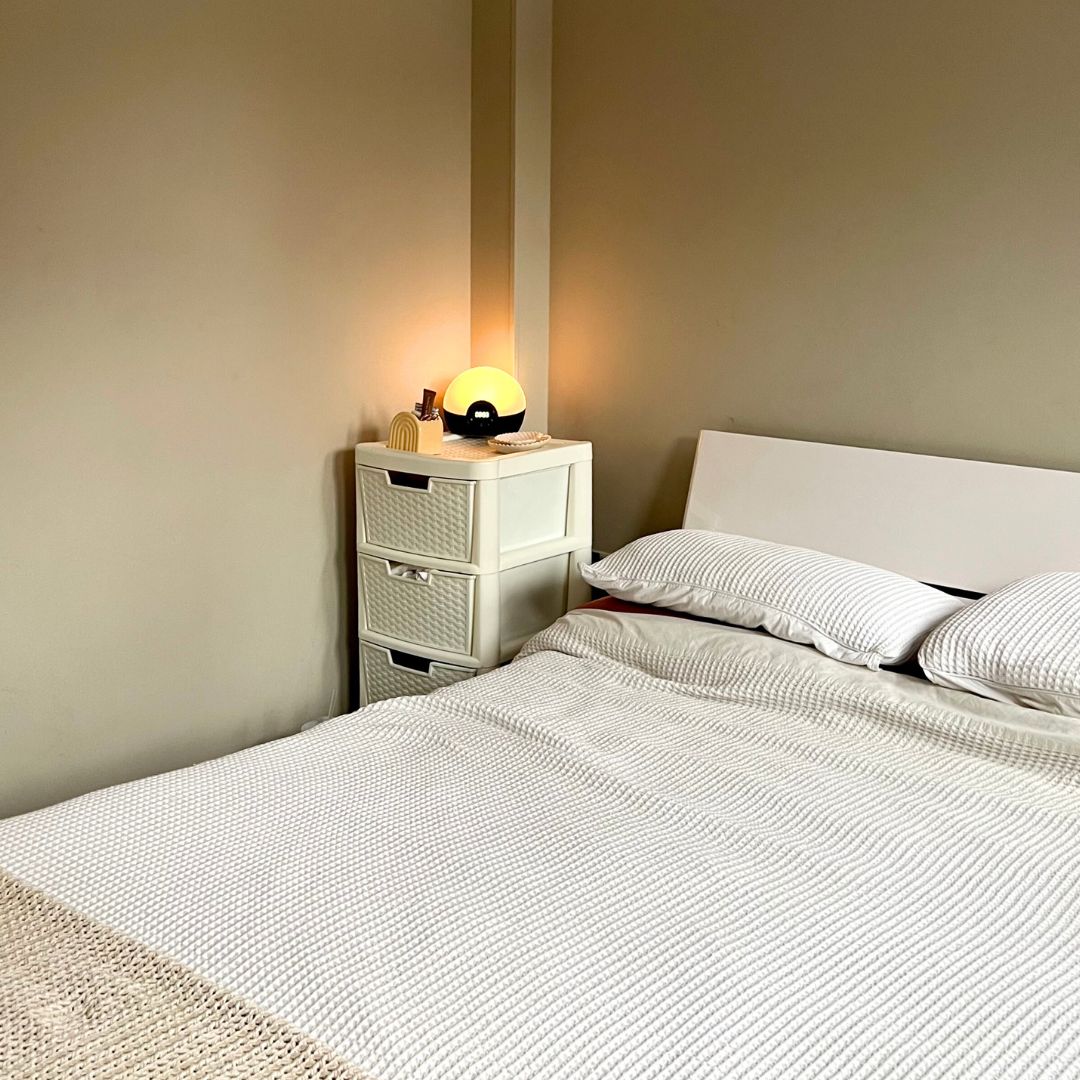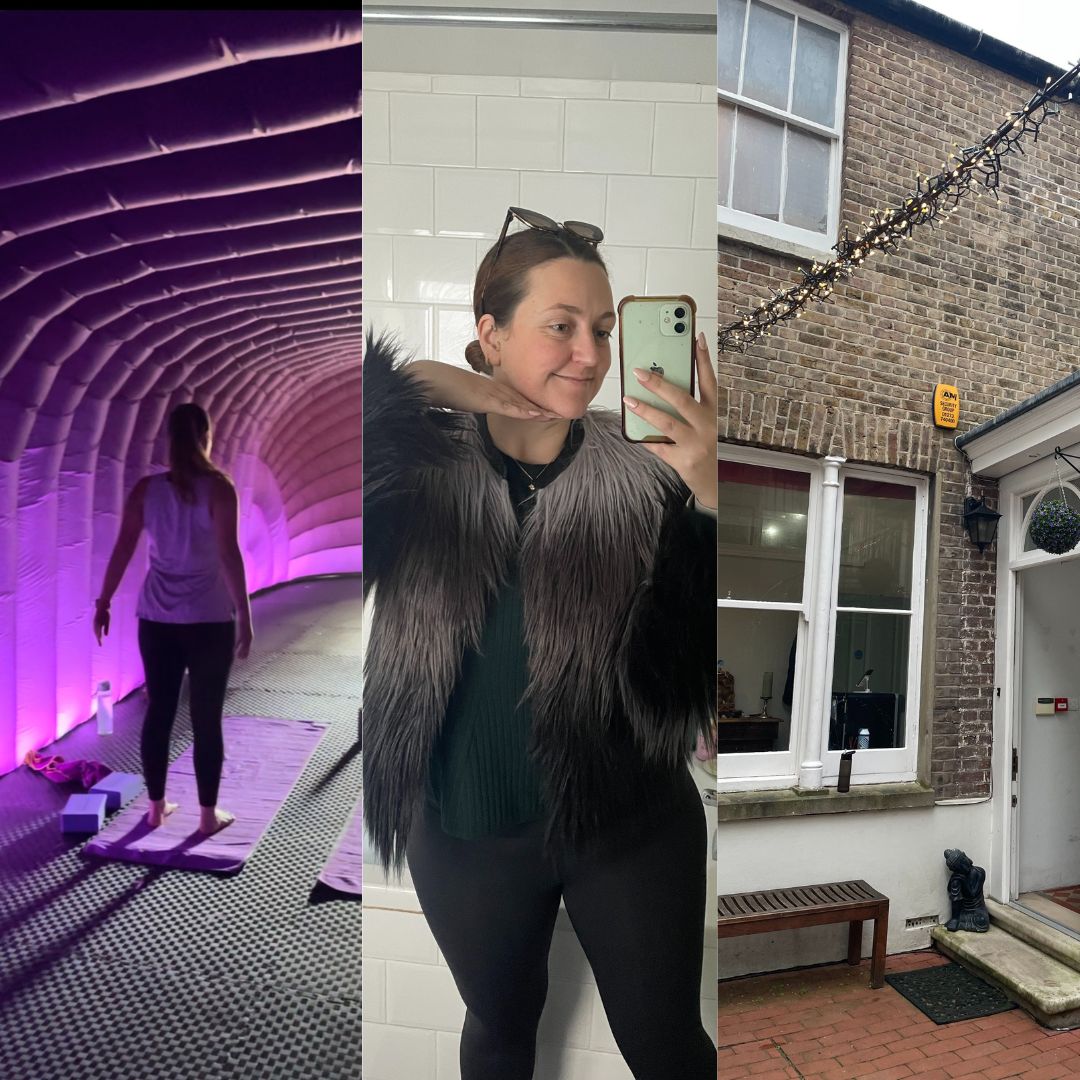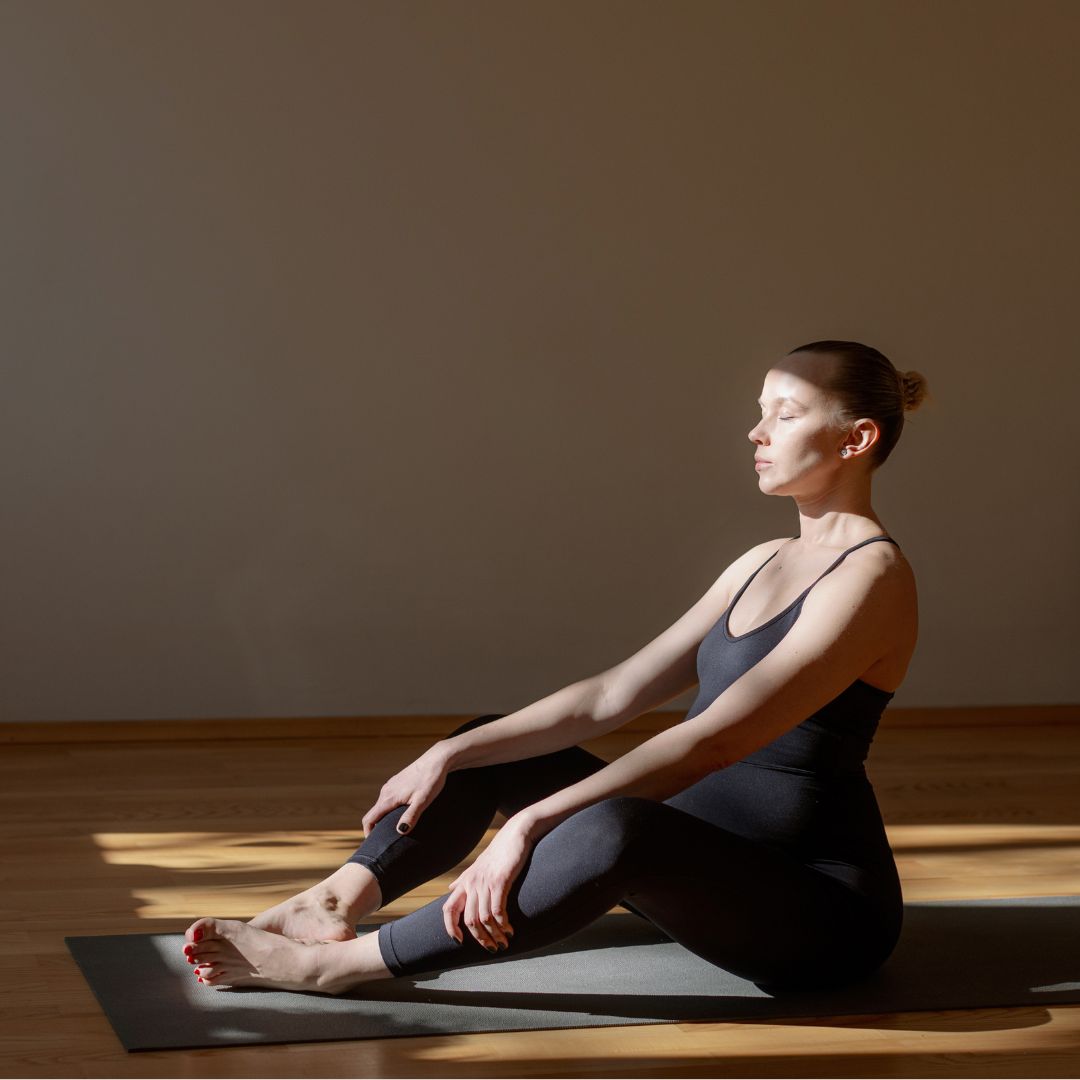I've worked in the fitness industry for 10+ years and long sworn by daily mobility training - why it's trending RN
It's so much more than stretching.


Mobility training is taking social media by storm RN, with Google Searches around upper body mobility and lower back mobility routines, up by over 5000%. On TikTok, mobility challenges like the shrimp challenge continue to go viral, with mobility routine creator Adam Richardson gaining such traction and popularity that he's just announced his first book deal, How To Build A Body That Lasts.
So, if you've seen influencers raving about mobility on your timelines or are one of the 93% of people in the UK who report suffering from body pains, stiffness or aches, it might be about time you gave it a go. That's according to the Global Pain Index, which also discovered that some experience pain so bad it prevents them from socialising or having sex.
While there are many, many reasons for body pain and improving and managing symptoms is very personal, there is one thing that can help with general aches and grievances, and that's mobility training. Trust me on this one - because, as a Fitness Editor, I've tried a lot in my time but mobility workouts are the ones I consistently tick off week in, week out thanks to how they make my body feel.
You see, I used to deal with consistent aches in my back, hips and shoulders (thanks, scoliosis and auto-immune illnesses), but ever since I started implementing mobility exercises into my day, I experience far fewer aches and pains. Not just that, but I noticed a serious improvement in my flexibility, strength, and balance, too.
Of course, mobility training didn't cure my pain or conditions, but it definitely improved my strength and the range of motion of my joints and my muscles which, in turn, helped my body deal with what I was asking of it.
And the research backs up my enthusiasm, too. One 2024 study in which 73 participants performed a mobility routine three days a week for twelve weeks found that not only did they notice improved range of motion and less stiffness, but also a boost to their overall well-being, with participants reporting a 70% reduction in tension, pain and discomfort.
Keen to learn more about mobility? You're in the right place. Don't miss our extensive guides to the best stretching workouts, warm-up exercises, and cool-down exercises, while you're here.
Marie Claire Newsletter
Celebrity news, beauty, fashion advice, and fascinating features, delivered straight to your inbox!
Google Search for mobility training is up +5000% at current - your guide
What is mobility training?
"Mobility training is moving to enhance the range motion and functional movement of the body’s joints and muscles," says Jo-Leigh Morris, head of mobility at BXR.
Your range of motion is how far your joints can safely move, such as how far your hips and shoulders can move. Your mobility is different from your flexibility. The latter describes how far a muscle can stretch, whereas mobility refers to how much strength and depth the joint has to move.
"Mobility training typically included a combination of stretching, strengthening and dynamic movements that target joint stability, muscle control and coordination," explains Morris.
A post shared by Jo-Leigh | Pilates (@joleighmorris)
A photo posted by on
What are the benefits of mobility training?
There are a whole range of benefits of including mobility moves in your weekly workouts. The main benefits span:
1. It'll improve your performance
Poor mobility can hold you back in the gym, sport or other training you do. For instance, if your hips aren't mobile enough for you to lower down very far in a squat position it will limit how well you can perform a barbell squat for lower-body strength. Working on your mobility will allow you to perform at your best.
2. It'll make daily movement easier
Your range of motion isn't just important for the gym, but for your day-to-day life too. Getting up and down off the floor, reaching things from a cupboard, safely carrying heavy items and loads more daily activities all require good mobility.
3. It'll reduce your risk of injury
And aches and pains, too. Another of the reasons why mobility training is so important is because your joints are made to move, but our sedentary and static lifestyles mean they're not used to their full potential, creating tension and tightness. Limbering up can improve aches and pains and make your body more resilient.
4. It'll keep you mobile for life
Even if you don't have to think twice right now about how well you can sit yourself down in a chair, consider how many older people struggle with that movement. Keeping up mobility now will pay off in later life when mobility naturally declines. In fact, the sit-to-rise test (moving from seated on the floor to standing, using as little support as possible) is an indicator of mortality, with those who used more than one hand or knee support having two-to-five fold higher death rates over six years, according to a seminal study.
Keen to incorporate mobility training? Follow these 3 top tips:
1. Make it an everyday practice:
Mobility training can be an hour-long process - or it can be a one-minute posture you practise in increments throughout the day. "A short amount daily is recommended, even if it’s just ten minutes," says Morris.
2. Work with your body and don't compare yourself to others
When you're strength training, you don't always lift the heaviest weight you possibly can. But when you're working on your mobility, you do need to work into your very end range. That doesn't mean moving a joint to the point of pain. Your end range is as far as you can safely take a movement, ensuring your form is on point and it doesn't hurt. "Mobility exercises are moving exercises that work the joint to end range. For instance, in a squat, you'd go down as low as you can to open the hips whilst maintaining a neutral spine," says Morris.
3. Get specific
We all have different mobility needs depending on our anatomy and lifestyles. Your end range may never be the same as someone else's, and there is such a thing as being too mobile (if you hyper-mobility, check in with an expert before adding mobility practice to your routine).
However, there are key areas we likely all need to work on, says Morris: "I especially think mobility routines should focus on the hips, spine and shoulders," she says.
4 mobility training workouts to try today:
1. 5-minute hip mobility routine by Katy Bath
What? A hip-focusd mobility routine that you can do in your own time.
Why? Your hips another area that need to stay strong and mobile for your health - but we spend so long sat still without moving them very far. This routine hits your hips in lots of different ways.
How long for? The routine would take around five minutes, but you can spend longer in each pose or pick and choose exercises if you only have a couple of minutes to spare.
A post shared by Katy Bath | Pilates by Katy (@katybath)
A photo posted by on
2. 10-minute shoulder mobility routine by Nourish Move Love
What? A quick but effective shoulder mobility routine with variations for beginners and those more advanced.
Why? Shoulder pain is so common and this routine is designed to loosen up the front, side and back of the area. Lindsey talks you through every movement in great detail so you can be sure you'll get it right.
How long for? It takes just 10 minutes.
3. Shona Vertue's 10-minute morning mobility
What? A full-body morning mobility routine from yogi, strength coach and fitness pro Shona Vertue.
Why? Though the mobility routine is just 10-minutes, Vertue spend a good seven minutes at the start of this video explaining exactly why mobility training is so good for you, making this brilliant for beginners to learn more about how and why to move their body in this sequence.
How long for? Once you've watched the intro the first time round, you can skip straight to the practise that lasts just 10 minutes.
4. 12-minute spinal mobility routine by Adam Richardson
What? A spine-focused mobility routine that's done mostly on the floor.
Why? Your spine should be able to move in four planes of motion: extension, flextion, rotation and lateral flexion - but most of us sit with our backs still and hunched. This video will help you move in all directions for better spinal health.
How long for? It takes just 12 minutes, so it's a great length to do on a work break.
Shop MC UK approved workout kit:

If you're about to start a regular mobility routine, you need a good, thick, comfy mat as a lot of your training will be done lying or kneeling. We love this thick, soft and beautiful mat.

Enter stage right, one of the best sports bras on the market if you like fit kit that's also fashion-forward. This gloriously sunny colourway from Adanola is chic and the design is seriously supportive, to boot.

Chloe Gray is a freelance journalist who writes and talks about health, fitness, and wellbeing through a feminist lens. She was part of the launch team for Stylist magazine's fitness brand, Strong Women, and has written for i news, Women's Health, Red magazine, Good Housekeeping, Refinery29, and more. She's all about building mental and physical strength, eating delicious food that fuels you well, and making the fitness industry more accessible and enjoyable. She's also a qualified fitness trainer and research nerd, so you can be sure everything you read is backed by proper science.
-
 Here's a rundown of The White Lotus cast members who have dated in real life
Here's a rundown of The White Lotus cast members who have dated in real lifeBy Jenny Proudfoot
-
 All the coolest brides are wearing drop-waist wedding dresses this year
All the coolest brides are wearing drop-waist wedding dresses this yearWedding Special Minimalist, nostalgic, and universally flattering
By Clementina Jackson
-
 Anya Hindmarch has just launched a fantastical diving shop in central London
Anya Hindmarch has just launched a fantastical diving shop in central LondonFor those who would rather be beside the seaside...
By Sofia Piza
-
 Road To Recovery: I'm a runner who currently can't run - how low impact exercise is helping me feel fitter than ever
Road To Recovery: I'm a runner who currently can't run - how low impact exercise is helping me feel fitter than everPlus, boosting my mental health tenfold, too.
By Ally Head
-
 I tried Jennifer Aniston's 80/20 approach to wellness - and can't tell you how refreshing I've found it
I tried Jennifer Aniston's 80/20 approach to wellness - and can't tell you how refreshing I've found itIt's all about balance.
By Katie Sims
-
 I tried doing a 10-minute power walk every morning for a week - it's the best energy boost I've ever tried
I tried doing a 10-minute power walk every morning for a week - it's the best energy boost I've ever triedOne to add to your routine?
By Katie Sims
-
 I tried the viral Mel Robbins morning routine for a week - and, having tested, totally get the hype
I tried the viral Mel Robbins morning routine for a week - and, having tested, totally get the hypeMy body clock is *finally* back on track.
By Nishaa Sharma
-
 I thought I'd hate hot yoga - but I've been shocked by how much it's transformed my fitness and flexibility
I thought I'd hate hot yoga - but I've been shocked by how much it's transformed my fitness and flexibilityIn a word: I'm hooked.
By Jadie Troy-Pryde
-
 Feeling frazzled RN? Your fail-safe guide to how to boost calm, any place, any time
Feeling frazzled RN? Your fail-safe guide to how to boost calm, any place, any timeTop pros share how they keep their cool.
By Camille Dubuis-Welch
-
 Feeling run down? 6 exercise moves that a trainer swears by to relieve tension and boost calm during busy periods
Feeling run down? 6 exercise moves that a trainer swears by to relieve tension and boost calm during busy periodsAnd... breathe.
By Ally Head
-
 I wrote my own dopamine menu after seeing them go viral - and can't stress how much it's boosted my wellbeing
I wrote my own dopamine menu after seeing them go viral - and can't stress how much it's boosted my wellbeingThis one's worth a try.
By Chloe Gray



